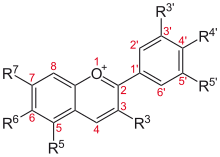Anthocyanin
Anthocyanin is a chemical compound which makes the red colour in plants. For example, red cabbage has anthocyanins which make it red.


Function
changeIn flowers, bright-reds and purples attract pollinators. In fruits, the colourful skins also attract the attention of animals, which may eat the fruits and disperse the seeds.
In photosynthetic tissues (such as leaves and sometimes stems), anthocyanins have been shown to act as a "sunscreen". They protect cells from high-light damage by absorbing blue-green and ultraviolet light. Ionizing radiation can damage DNA.
There are some other suggestions. The red colour of leaves may camouflage leaves from herbivores blind to red wavelengths. The pigment may signal bad taste, since anthocyanin synthesis often comes with unpalatable phenolic compounds.[1]
Making these pigments is done by a series of enzymes that are stuck on cell membranes.[1]
References
change- ↑ 1.0 1.1 Jack Sullivan (1998). "Anthocyanin". Carnivorous Plant Newsletter (CPN) September 1998. Archived from the original on 1 November 2009. Retrieved 6 October 2009.